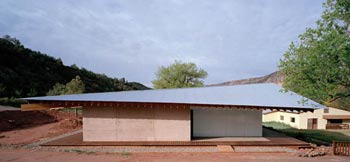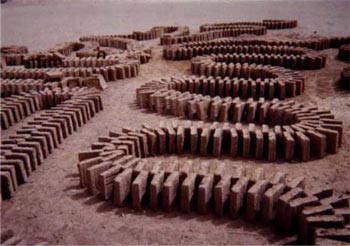From Issue # 23 – September/October 1973 of the Mother Earth News, “How to Build a Rammed Earth House” written by John O. McMeekin: “Back in the 40’s I was considered an oddball. I wore a beard — revolutionary then — and I started, by myself, to build a house out of (of all things) rammed earth. People wondered about me. Today — as a V.P. and corporation director — I appear Establishment, and my home doesn’t look unusual either. It hugs a hilltop landscape, it’s surrounded by spacious lawns and sheltered by big oaks … and in the garage are two (count them, two) Mercedes. But my house is still made of rammed earth.
Dachverband Lehm
Dachverband Lehm is a German organization interested in promoting the culture of building with earth. The association sees itself as an umbrella organization for all those interested in earth and earthen building. The organization coordinates and concentrates the various activities of its members. Dachverband Lehm was established in 1992 as an association to promote the culture of building with earth and to represent all those interested or working in the field. Today they are the internationally recognised representative in Germany for clay and earth building. Their work in establishing technical building regulations, the “Lehmbau Regeln”, and their vocational training programme “Specialist for Building with Earth”, recognized by the Chamber of Trade and Commerce, are exemplary in Germany.
Their website offers a series of interesting links regarding international earth building.
Adobe Architecture
The North Texas Institute for Educators on the Visual Arts offers a concise history and explaination of adobe architecture.
David Easton
The Rammed Earth House written by David Easton, describes the beauty and grace of rammed earth construction. The photographs of different structures, both modern and ancient, by Cynthia Wright, create a breathtaking glimpse into a building technique that is as old as human history, but exactly suitable for today’s resource-conscious and environmentally friendly building needs. Rammed Earth Works, established in 1978, has distinguished itself as one of the world’s leading company in the research and development of modern earth construction technologies. Founder David Easton is the internationally recognized developer of PISE, Terratile, the Easton forming system for rammed earth and cast elements, and construction systems for engineered earth walls which are code compliant and compatible with current building trades.
Center of Gravity Hall

This new teaching hall for the Bodhi Mandala Zen Center in Jemez Springs, New Mexico was designed by Predock Frane Architects of Los Angeles and uses rammed earth. The project was a recipient of a 2003 AIA/Los Angeles Design Honor Award.
The Gaiapolis Foundation
The Gaiapolis Foundation, in Sofia, Bulgaria, is a non-profit non-government organization who address the investigation, dissemination, and application of different earthen building technologies (adobe, rammed earth and cob) for the construction of social housing.
D. Francis Kéré

German trained architect, D. Francis Kéré, has designed a simple and beautiful mud brick school house in his homeland of Burkina Faso. More on the project at the German language website: www.fuergando.de
Translate to English at babelfish
South Dakota Rammed Earth
Ralph Patty, Chairman of the Agricultural Engineering Department, supervised the rammed earth research at South Dakota State College in the 1920s and 1930s. Patty’s research was published internationally as well as by SDSC and the USDA Rammed Earth Walls for Buildings- 1926 :Farmers’ Bulletin #1500.
Banco: Adobe Mosques of the Inner Niger Delta

Banco: Adobe Mosques of the Inner Niger Delta by Sebastian Schutyser and Jean Dethier (author of Down to Earth) et al., is a beautiful book with photographs by Sebastian Schutyser that reveal a neglected African architectural heritage: village adobe mosques. His black-and-white images emphasize an artistic fusion of architecture and sculpture and exalt the strength and beauty of a craft that eludes globalization. The photos emphasize the grain and substance of clay smoothed by villagers’ hands or cracked by erosion, and highlight the solidity of the masonry and the sensuality of the textures. The texts that accompany these stunning pictures are by a leading expert on raw-earth architecture and by a major scholar on African vernacular architecture. Included is an appendix that documents all 500 of the principal adobe mosques of the Inner Niger Delta, with the names of the villages and geographical coordinates. For more information visit www.sebastianschutyser.com
Drying Mud Bricks

Sun dried mud bricks, called “Khesht” in Iran, are laid on their side to promote even drying. The patterns created in a landscape of mudbricks can also be considered as an aesthetic part of the process of building with earth. These bricks are being prepared for the restoration of the Naren Rampart in Yzad, Iran. Image by Dr. Hossein Massoud, 2001
